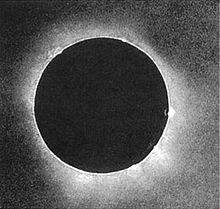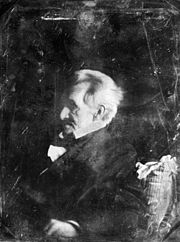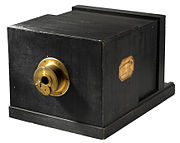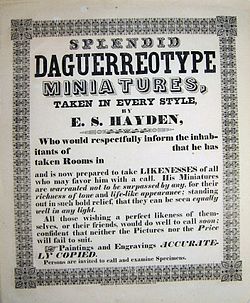- Daguerreotype
-
 1840-1841 Camerae obscurae and plates for Daguerreotype called "Grand Photographe" produced by Charles Chevalier (Musée des Arts et Métiers)
1840-1841 Camerae obscurae and plates for Daguerreotype called "Grand Photographe" produced by Charles Chevalier (Musée des Arts et Métiers)
 L'Atelier de l'artiste. An 1837 daguerreotype by Daguerre, the first to complete the full process.[1]
L'Atelier de l'artiste. An 1837 daguerreotype by Daguerre, the first to complete the full process.[1]
The daguerreotype
 /dəˈɡɛrətaɪp/ (French: daguerréotype) was the first commercially successful photographic process. The image is a direct positive made in the camera on a silvered copper plate. The raw material for plates was called Sheffield plate, plating by fusion or cold-rolled cladding and was a standard hardware item produced by heating and rolling silver foil in contact with a copper support. [2] The surface of a daguerreotype is like a mirror, with the image made directly on the silvered surface; it is very fragile and can be rubbed off with a finger, and the finished plate has to be angled so as to reflect some dark surface in order to view the image properly. Depending on the angle viewed, and the color of the surface reflected into it, the image can change from a positive to a negative.
/dəˈɡɛrətaɪp/ (French: daguerréotype) was the first commercially successful photographic process. The image is a direct positive made in the camera on a silvered copper plate. The raw material for plates was called Sheffield plate, plating by fusion or cold-rolled cladding and was a standard hardware item produced by heating and rolling silver foil in contact with a copper support. [2] The surface of a daguerreotype is like a mirror, with the image made directly on the silvered surface; it is very fragile and can be rubbed off with a finger, and the finished plate has to be angled so as to reflect some dark surface in order to view the image properly. Depending on the angle viewed, and the color of the surface reflected into it, the image can change from a positive to a negative.The very first daguerreotypes used Chevalier lenses that were "slow", and the light sensitive material was silver iodide made by fuming the plate with iodine vapour. This meant that the exposure in the camera was too long to conveniently take portraits, and the first subjects taken were street scenes and architectural studies. When Petzval lenses were introduced, with lenses of a larger diameter and the plate was sensitized with iodine and bromine forming light sensitive crystals of silver iodide and silver bromide, the exposures were reduced so that portraits could be taken. Usually, it was arranged so that the sitters leant their elbows on a support, or else head rests that did not show in the picture were used to help the sitters sit motionless, and this led to most daguerreotype portraits having stiff, lifeless poses. There were exceptions with lively expressions full of character by photographers who saw the potential of the new medium, and these are represented in museum collections and are the most sought after by private collectors today.
Daguerreotypes were mounted in cases under glass with a cover, or else in a frame that could be hung on a wall. Photographic processes that were invented soon after: ambrotypes and tintypes were mounted in similar cases, but were made by the later wet plate process using collodion on glass or on a bitumen coated iron plate. These can be distinguished from daguerreotypes by the image quality. The polished silver surface of a daguerreotype gives a feeling of presence where the image appears to be floating in space.
The process was developed by Louis Daguerre together with Joseph Nicéphore Niépce. Niepce had produced the first photographic image in the camera obscura using asphaltum on a copper plate sensitised with lavender oil that required exposures as long as eight hours.
The image in a daguerreotype is often described as being formed by the amalgam, or alloy, of mercury and silver because mercury vapor from a pool of heated mercury is used to develop the plate; but using the Becquerel process (using a red filter and two-and-a-half stops extra exposure) daguerreotypes can be produced without mercury, and chemical analysis shows that there is no mercury in the final image with the Bequerel process. This leads to questioning the theory that the image is formed of amalgam with mercury development.
Exposure times were later reduced by sensitising the plate with other silver halides: silver bromide and silver chloride, and by replacing the Chevalier lenses with much larger, faster lenses designed by Joseph Petzval. A reduction in camera size and the size of the image will always result in more light reaching the image plane and consequently reduced exposures, and a small camera that produces small circular images was made by Voigtländer.
The image is formed on the surface of the silver plate (resembling the surface of a mirror) and is unstable; it can easily be rubbed off and will oxidize in the air, so from the outset daguerreotypes were mounted in sealed cases or frames with a glass cover.
When viewing the daguerreotype, a dark surface is reflected into the mirrored silver surface, and the reproduction of detail in sharp photographs is very good.
Although daguerreotypes are unique images, they could be copied by redaguerreotyping the original.[3]
Contents
Invention
Since the late Renaissance, artists and inventors had been looking for a mechanical method of capturing visual scenes.[4] Previously, using the camera obscura, artists would manually trace what they saw, or use the optical image in the camera as a basis for solving the problems of perspective and parallax, and deciding colour values. The camera obscura's optical reduction of a real scene in three-dimensional space to a flat rendition in two dimensions influenced western art, so that at one point, it was thought that images based on optical geometry (perspective) belonged to a more advanced civilization. Later, with the advent of Modernism, the absence of perspective in oriental art from China, Japan and in Persian miniatures was revalued.
Previous discoveries of photosensitive methods and substances—including silver nitrate by Albertus Magnus in the 13th century,[5] a silver and chalk mixture by Johann Heinrich Schulze in 1724,[citation needed] and Joseph Niépce's bitumen-based heliography[4] in 1822[6] —contributed to development of the daguerreotype. In 1829 French artist and chemist Louis J.M. Daguerre, contributing a cutting edge camera design, partnered with Niépce, a leader in photochemistry, to further develop their technologies.[4]
After Niépce's 1833 death, Daguerre continued to research the chemistry and mechanics of recording images by coating copper plates with iodized silver.[4] Early experiments required hours of exposure in the camera to produce visible results. In 1835 Daguerre discovered—after accidentally breaking a mercury thermometer, according to traditional accounts—a method of developing the faint or invisible images on plates that had been exposed for only 20 to 30 minutes.[4] Further refinement of his process would allow him to fix the image—preventing further darkening of the silver—using a strong solution of common salt. The 1837 still life of plaster casts, a wicker-covered bottle, a framed drawing and a curtain—titled L'Atelier de l'artiste—was his first daguerreotype to successfully undergo the full process of exposure, development and fixation.[4]
The French Academy of Sciences announced the daguerreotype process on January 9, 1839. Later that year William Fox Talbot announced his silver chloride "sensitive paper" process. Together, these announcements mark 1839 as the year photography was born.[7]
Daguerre did not patent and profit from his invention in the usual way. Instead, it was arranged that the French government would acquire the rights in exchange for a lifetime pension. The government would then present the daguerreotype process "free to the world" as a gift to mankind, which it did on August 19, 1839. However, on August 14, 1839, Miles Berry, acting on Daguerre's behalf, filed for a patent in England, which consequently became the only place on Earth where the purchase of a license was legally required.[8]
Daguerreotype process
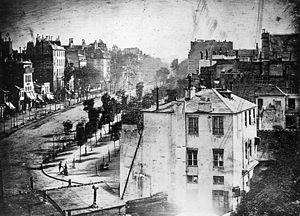 Boulevard du Temple, Paris, Spring 1838, by Daguerre (the first photograph of a person ever made). The image shows a busy street, but because exposure time was more than ten minutes, the moving traffic does not appear. Only a man getting his boots polished, the shoe-shine boy, and two people sitting at a table nearby stood still long enough for their image to be captured. The image is reversed (as were most Daguerreotypes) as is evidenced by the writing on a building in upper left.
Boulevard du Temple, Paris, Spring 1838, by Daguerre (the first photograph of a person ever made). The image shows a busy street, but because exposure time was more than ten minutes, the moving traffic does not appear. Only a man getting his boots polished, the shoe-shine boy, and two people sitting at a table nearby stood still long enough for their image to be captured. The image is reversed (as were most Daguerreotypes) as is evidenced by the writing on a building in upper left.
 The first authenticated image of Abraham Lincoln was this daguerreotype of him as U.S. Congressman-elect in 1846, attributed to Nicholas H. Shepard of Springfield, Illinois
The first authenticated image of Abraham Lincoln was this daguerreotype of him as U.S. Congressman-elect in 1846, attributed to Nicholas H. Shepard of Springfield, Illinois

The daguerreotype, along with the Tintype, is a photographic image allowing no direct transfer of the image onto another light-sensitive medium, as opposed to glass plate or paper negatives. Preparation of the copper[9] plate prior to image exposure resulted in the formation of a layer of photo-sensitive silver halide, and exposure to a scene or image through a lens formed a latent image. The latent image was made visible, or "developed", by placing the exposed plate over a slightly heated (about 30°C / 90°F) cup of mercury[10]. Daguerre was first to discover and publish (in the publication of the process and the English patent of 1839) the principle of latent image development.
The mercury vapour condensed on those places on the plate where the exposure light was most intense (highlights), and less so in darker areas of the image (shadows). This produced a picture in an amalgam, the mercury washing the silver out of the halides, solubilizing and amalgamating it into free silver particles which adhered to the exposed areas of the plate, leaving the unexposed silver halide ready to be removed by the fixing process. This resulted in the final unfixed image, which consisted of light and dark areas of grey amalgam on the plate. The developing box was constructed to allow inspection of the image through a yellow glass window to allow the photographer to determine when to stop development.
The next operation was to "fix" the photographic image permanently on the plate by dipping in a solution of hyposulphite of soda[11], often called "fixer" or "hypo", to dissolve the unexposed halides. Initially, Daguerre's process was to use a saturated salt solution for this step, but later adopted Herschel's suggestion of sodium thiosulphate, as did W. H. F. Talbot.
The image produced by this method is extremely fragile and susceptible to damage when handled. Practically all daguerreotypes are protected from accidental damage by a glass-fronted enclosure. It was discovered by experiment that treating the plate with heated gold chloride both tones and strengthens the image, although it remains quite delicate and requires a well-sealed enclosure to protect against touch as well as oxidation of the fine silver deposits forming the blacks in the image. The best-preserved daguerreotypes dating from the 19th century are sealed in robust glass cases evacuated of air and filled with a chemically inert gas, typically nitrogen.
Proliferation
André-Adolphe-Eugène Disdéri[12] and Jules Itier[13] in France, and Johann Baptist Isenring in Switzerland, became prominent daguerreotypists. In the United Kingdom, however, Richard Beard bought the British daguerreotype patent from Miles Berry in 1841 and closely controlled his investment, selling licenses throughout the country and prosecuting infringers.[14] Among others, Antoine Claudet[15] and Thomas Richard Williams[16] produced daguerreotypes in the U.K.
Daguerreotype photography spread rapidly across the United States. In the early 1840s, the invention was introduced in a period of months to practitioners in the United States by Samuel Morse[17], inventor of the telegraph code. One of these original Morse Daguerreotype cameras is currently on display at the National Museum of American History, a branch of the Smithsonian, in Washington, DC.[7] A flourishing market in portraiture sprang up, predominantly the work of itinerant practitioners who traveled from town to town. For the first time in history, people could obtain an exact likeness of themselves or their loved ones for a modest cost, making portrait photographs extremely popular with those of modest means. Notable U.S. daguerreotypists of the mid-19th century included James Presley Ball,[18] Samuel Bemis,[19] Abraham Bogardus,[19] Mathew Brady,[20] Thomas Martin Easterly,[21]François Fleischbein, Jeremiah Gurney,[22] John Plumbe, Jr.,[23] Albert Southworth,[24] Augustus Washington,[25] Ezra Greenleaf Weld,[26] and John Adams Whipple.[19]
This method spread to other parts of the world as well. In 1857, Ichiki Shirō created the first known Japanese photograph, a portrait of his daimyo Shimazu Nariakira. This photograph was designated an Important Cultural Property by the government of Japan.[citation needed]
The daguerreotype is commonly, erroneously, believed to have been the dominant photographic process into the late part of the 19th century in Europe. Evidence from the period shows that it was in widespread use for less than twenty years before being superseded by other processes:
- The calotype, introduced in 1841; a negative-positive process using a paper negative.
- The collodion wet plate process, introduced in 1851; a negative-positive process using halide-impregnated collodion poured from a bottle onto a glass plate and sensitized by immersion in a silver nitrate bath.
The collodion wet plate process was used to produce ambrotypes on glass and tintypes or ferrotypes on a coated iron plate.
- The ambrotype, introduced in 1854; a negative image on glass which appeared positive when on dark "ruby" glass or backed with a black varnish or cloth.
- The tintype or ferrotype, introduced in 1856; an image like the ambrotype, but on a thin blackened iron plate instead of glass.
Demise
The intricate, complex, labor-intensive daguerreotype process itself helped contribute to the rapid move to the ambrotype and tintype. The proliferation of these simpler and much less expensive photographic processes made the costly daguerreotypes less appealing to the average person (although it remained very popular in astronomical observatories until the invention of glass plate cameras). According to Mace (1999), the rigidity of these images stems more from the seriousness of the activity than a long exposure time, which he says was actually only a few seconds (Early Photographs, p. 21). The daguerreotype's lack of a negative image from which multiple positive "prints" could be made was a limitation also shared by the tintype, but was not a factor in the daguerreotype's demise until the introduction of the calotype. The fact that many of those to use the process suffered severe health problems or even death from mercury poisoning after inhaling toxic vapors created during the heating process also contributed to its falling out of favor with photographers.[27] Unlike film and paper photography however, a properly sealed daguerreotype can potentially last indefinitely.
The daguerreotype's popularity was not threatened until photography was used to make imitation daguerreotypes on glass positives called ambrotypes, meaning "imperishable picture" (Newhall, 107).[19]
Modern daguerreotypes
Although the daguerreotype process is usually said to have died out completely in the early 1860s, documentary evidence indicates that some slight use of it persisted more or less continuously throughout the following 150 years of its supposed extinction.[28] A few first-generation daguerreotypists refused to entirely abandon their beautiful old medium when they started making the new, cheaper, easier to view but comparatively drab ambrotypes and tintypes.[29] Historically-minded photographers of subsequent generations, fascinated by daguerreotypes, sometimes experimented with making their own or even revived the process commercially as a "retro" portraiture option for their clients.[30][31] The daguerreotype experienced a minor renaissance in the late 20th century and the process is currently practiced by a handful of enthusiastic devotees; there are thought to be fewer than 100 worldwide (see list of artists on cdags.org in links below). In recent years artists like Jerry Spagnoli, Adam Fuss and Chuck Close have reintroduced the medium to the broader art world. Its appeal lies in the "magic mirror" effect of light striking the polished silver plate and revealing a silver image which can seem ghostly and ethereal even while being perfectly sharp, and in the sense of achievement derived from the dedication and handcrafting required to make a daguerreotype.
Value in the marketplace
The value of a typical small daguerreotype portrait ranges from as little as US $20 for a damaged or unappealing image with no case to a more normal average of US $50 to $100 for an undamaged portrait of a reasonably attractive or interesting sitter, a complete case usually being required for the high-end price. Elaborate molded or inlaid cases add significant value when in good condition. Identification of the sitter by some type of included old documentation adds modestly to the value. Larger "half plate" and "whole plate" size (the latter is 6.5 by 8.5 inches) portraits are uncommon and more valuable, as are portraits which have been hand-tinted with multiple colors rather than simple daubs of rouge on cheeks or touches of gold paint on jewellery, although these also add modestly to the value. The premium is proportional to the subtlety and quality of the coloring. Because the vast majority of daguerreotypes are simple, straightforward studio portraits of ordinary people, normally it is some unusual feature which elevates the value to a multiple of the average. Men in uniform, "occupational" portraits showing a sitter with the tools of the trade, and subjects shown with weapons or other unusual objects are in this category.
Daguerreotypes other than portraits, such as landscape or architectural views, are very rare and may safely be valued from an absolute minimum of US $500 steeply upward unless severely damaged or exceptionally uninteresting. Images with major inherent historical interest, such as Gold Rush and other pioneer or urban scenes, sell for many thousands of dollars even with significant damage.
Portraits of outstanding quality with the maker's marks of highly-regarded daguerreotypists such as Southworth & Hawes of Boston, George S. Cook of Charleston, Gurney, Pratt and others are now valued as photographic works of art rather than as antiques or curios, and they fetch corresponding prices when sold at auction. Most valuable of all, when the identity of the subject can be established beyond any reasonable doubt, are authentic original daguerreotypes of very famous people. A damaged daguerreotype copy of one of the nine original daguerreotypes known to have been made of Edgar Allan Poe was featured on the PBS show Antiques Roadshow and appraised at US $30,000 to $50,000. In 2006, Sotheby's sold it for US $150,000. The copy was made by William Abbott Pratt circa 1854 from an original he made two weeks before Poe's 1849 death.[32]
In May 2007, an anonymous buyer paid 576,000 euros for an original 1839 camera made by Susse Frères (Susse brothers), Paris, at an auction in Vienna, Austria, making it the world's oldest and most expensive commercial photographic apparatus.[33] The 2007 record was then bested by another daguerrotype camera, this time with Daguerre's signature on the device. It sold for 732,000 euros.[34]
Footnotes
- ^ Carlisle, Rodney P. Scientific American Inventions and Discoveries: All the Milestones in Ingenuity—From the Discovery of Fire to the Invention of the Microwave Oven. New Jersey: John Wiley & Sons, Inc., 2004. ISBN 0471244104
- ^ The daguerreotype: nineteenth-century technology and modern science By M. Susan Barger, William Blaine White
- ^ Memory.loc.gov
- ^ a b c d e f Stokstad, Marilyn; David Cateforis, Stephen Addiss (2005). Art History (Second ed.). Upper Saddle River, New Jersey: Pearson Education. pp. 964–967. ISBN 0-13-145527-3.
- ^ Szabadváry, Ferenc (1992). History of analytical chemistry. Taylor & Francis. p. 17. ISBN 2881245692. http://books.google.com/books?id=53APqy0KDaQC.
- ^ "The First Photograph - Heliography". http://www.hrc.utexas.edu/exhibitions/permanent/wfp/heliography.html. Retrieved 2009-09-29. "from Helmut Gernsheim's article, "The 150th Anniversary of Photography," in History of Photography, Vol. I, No. 1, January 1977: ... In 1822, Niépce coated a glass plate ... The sunlight passing through ... This first permanent example ... was destroyed ... some years later."
- ^ a b "A Daguerreotype of Daguerre". National Museum of American History, Smithsonian Institution. http://historywired.si.edu/object.cfm?ID=458. Retrieved 2008-07-17.
- ^ Articles by R. Derek Wood on the history of the daguerreotype at "Midley History of early Photography". http://www.webarchive.org.uk/wayback/archive/20100311230213/http://www.midley.co.uk/.
- ^ http://memory.loc.gov/ammem/daghtml/dagdag.html
- ^ http://memory.loc.gov/ammem/daghtml/dagdag.html
- ^ http://memory.loc.gov/ammem/daghtml/dagdag.html
- ^ J. Paul Getty Museum. André Adolphe-Eugène Disdéri. Retrieved 2009-08-09.
- ^ J. Paul Getty Museum. Jules Itier. Retrieved 2009-08-09.
- ^ Wood, R. Derek. "The Daguerreotype in England: Some Primary Material Relating to Beard's Lawsuits." History of Photography, October 1979, Vol. 3, No. 4, pp. 305–9.
- ^ J. Paul Getty Museum. Antoine Claudet. Retrieved 2009-08-09.
- ^ J. Paul Getty Museum. Thomas Richard Williams. Retrieved 2009-08-09.
- ^ http://americanhistory.si.edu/collections/object.cfm?key=35&objkey=142
- ^ Cincinnati Historical Society Library. J. P. Ball, African American Photographer. Retrieved 2009-08-08.
- ^ a b c d Newhall, Beaumont. The daguerreotype in America. 3rd rev. ed. New York: Dover Publications, 1976. ISBN 0486233227.
- ^ Leggat, Robert. A History of Photography from its Beginnings till the 1920s. Brady, Mathew. 1999. Retrieved 2009-08-09.
- ^ J. Paul Getty Museum. Thomas Martin Easterly. Retrieved 2009-08-08.
- ^ J. Paul Getty Museum. Jeremiah Gurney. Retrieved 2009-08-08.
- ^ J. Paul Getty Museum. John Plumbe, Jr. Retrieved 2009-08-08.
- ^ Young America: The Daguerreotypes of Southworth & Hawes. Biographies. Albert S. Southworth. International Center of Photography and George Eastman House, 2005-2006. Retrieved 2009-08-09.
- ^ National Portrait Gallery. A Durable Memento. Portraits by Augustus Washington, African American Daguerreotypist. Retrieved 2009-08-08.
- ^ J. Paul Getty Museum. Ezra Greenleaf Weld. Retrieved 2009-08-08.
- ^ Unlocking the Secrets in Old Photographs, p. 126. 1991. http://books.google.com/books?id=Tdk4eVF0nbIC&pg=PA126&dq=mercury+poisoning+from+daguerreotypes. Retrieved 2009-06-29.
- ^ Nelson, Kenneth E. (1996). "A Thumbnail History of the Daguerreotype"
- ^ Davis, D.T. (November 1896). "The Daguerreotype in America" McClure's Magazine 8(1):4-16. Near the end of this article, the author notes that the venerable Mr. Hawes, of Southworth and Hawes, has "a number of daguerreotypes made recently, for he is one of the few operators who remain loyal to the old process". Available online from the Daguerreian society
- ^ Tennant, John A. (August 1902). "Copying methods" The Photo-Miniature 4(41):201 et seq. See page 202 for mention of new daguerreotypes being made circa the 1890s by recycling old plates. (Selected text available online from The Daguerreian Society)
- ^ Cannon, Poppy. (June 1929). "An Old Art Revived" The Mentor 17(5):36-37 Available online from The Daguerreian Society
- ^ Artnet.com
- ^ "LOT 2 - Le Daguerréotype Susse Frères". WestLicht Auction. May 2007. http://www.westlicht-auction.com/index.php?id=76799&acat=76799&lang=3. Retrieved 2007-08-30.. A slightly different value is given by AFP: "Oldest/Most Expensive Camera". Media Speak, Inc.. 2007-05-28. http://www.pixnoir.com/2007/05/oldestmost_expensive_camera.php. Retrieved 2007-08-30.
- ^ France24.com
Further reading
- Gernsheim, Helmut, and Alison Gernsheim. L.J.M. Daguerre: the history of the diorama and the daguerreotype. New York: Dover Publications, 1968. ISBN 048622290X
- Rudisill, Richard. Mirror image: the influence of the daguerreotype on American society. Albuquerque: University of New Mexico Press, 1971.
- Coe, Brian. The birth of photography: the story of the formative years, 1800-1900. London: Ash & Grant, 1976. ISBN 0904069060
- Sobieszek, Robert A, Odette M Appel-Heyne, and Charles R Moore. The spirit of fact: the daguerreotypes of Southworth & Hawes, 1843-1862. Boston: D.R. Godine, 1976. ISBN 0879231793
- Pfister, Harold Francis. Facing the light: historic American portrait daguerreotypes : an exhibition at the National Portrait Gallery, September 22, 1978-January 15, 1979. Washington, DC: Published for the National Portrait Gallery by the Smithsonian Institution Press, 1978.
- Richter, Stefan. The art of the daguerreotype. London: Viking, 1989. ISBN 067082688X
- Barger, M Susan, and William B White. The daguerreotype: nineteenth-century technology and modern science. Washington: Smithsonian Institution Press, 1991. ISBN 0874743486
- Wood, John. America and the daguerreotype. Iowa City: University of Iowa Press, 1991. ISBN 0877453349
- Wood, John. The scenic daguerreotype: Romanticism and early photography. Iowa City: University of Iowa Press, 1995. ISBN 0877455112
- Lowry, Bates, and Isabel Lowry. The silver canvas: daguerreotype masterpieces from the J. Paul Getty Museum. Los Angeles: The Museum, 1998. ISBN 0892363681
- Davis, Keith F, Jane Lee Aspinwall, and Marc F Wilson. The origins of American photography: from daguerreotype to dry-plate, 1839-1885. Kansas City, MO: Hall Family Foundation, 2007. ISBN 9780300122862
External links
- International Contemporary Daguerreotypes community (non profit org)
- The Daguerreian Society: History, and predominantly US oriented database & galleries
- The Daguerreotype: an Archive of Source Texts, Graphics, and Ephemera
- Daguerreotype Portraits and Views, 1836-1864: US Library of Congress
- The American Handbook of the Daguerreotype from Project Gutenberg
- The Social Construction of the American Daguerreotype Portrait
- Article on daguerreotypes from Discover Magazine
- A University of Utah Podcast on Daguerreotype Theories
- Daguerreotype Plate Sizes
- Library of Congress Collection
- Cased Photos The Boston Public Library's Cased Photo Collection on Flickr.com
- Daguerreotype collection at the Canadian Centre for Architecture
Categories:- 1837 introductions
- 19th century in art
- Photographic processes dating from the 19th century
- Alternative photographic processes
Wikimedia Foundation. 2010.

